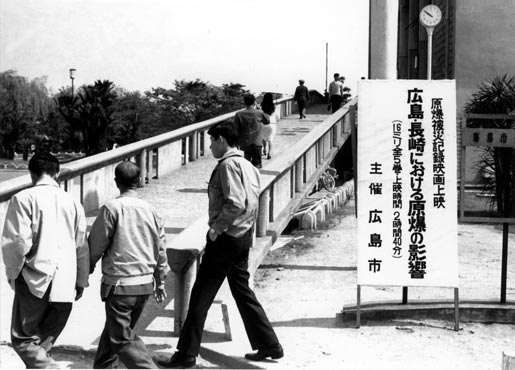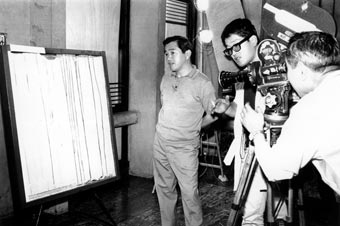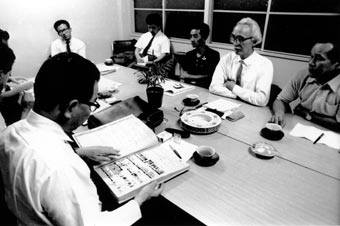Return of the Film 21 Years Later
With the end of the occupation in 1952, parts of the concealed film found their way into newsreels and movies.
The scientists who collaborated in the filming as members of the academic survey teams appealed through their American counterparts for the return of the film.
In 1967, the news broke that the U.S. government was considering returning the film and that negotiations had been initiated with the Japanese government. Finally, 21 years later, a copy from the original film was returned to Japan.

[56]
Thick paper on which names of film producers are written
September 2, 1967
Collection of Katsu Obata
The assembly of A-bomb documentary film producers sought the public release of the complete film that was returned, and appealed for the return of clearer film. |

[57]
Public release of film
May 2, 1968 Nakajima-cho Hiroshima City Auditorium
Courtesy of Chugoku Shimbun
After the opinions of the production personnel from the Japan Film Corporation were sought with regard to the public release of the returned film, a "meeting concerning the storage and use of the A-bomb documentary film" was set up and discussions were held. The Ministry of Education decided to release the film to the general public after cutting out certain parts to protect the human rights of people shown in the film. A Japanese-language edition was created for the general public and was loaned to the city of Hiroshima. A screening of the film then took place at the Hiroshima City Auditorium. |

[58]
The making of a new film
June 21, 1970 Nakajima-cho Hiroshima Peace Memorial Museum
Courtesy of Chugoku Shimbun
On May 19, 1970, the A-bomb Film Production Committee was established in the city of Hiroshima. Also, production began on a new A-bomb documentary film by Nippon Eiga Shinsha (formerly, the Japan Film Corporation). This film utilized parts that had been cut from the returned film. The aim of the film was to present a clear picture of Hiroshima at the time of the atomic bombing and the impact that the bombing has continued to have up to the present. |

[59]
Campaign seeking showing of no-cut edition
September 12, 1968 Hatchobori Hiroshima YMCA
Courtesy of Chugoku Shimbun
Some A-bomb survivor organizations and film producers began seeking the public release of the complete film. On June 6, 1968, in Hiroshima, a meeting promoting the public release of the complete A-bomb documentary film was organized. Efforts were then made to gain the approval of the survivors who appeared in the parts that were cut. |




